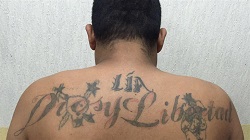The arrest in Argentina of a drug boss with apparent links to the Mara Salvatrucha has sparked fears that the Central American gang has expanded into the country, but this is far from a foregone conclusion.
Buenos Aires police have arrested Peruvian national Richard Castillo Salazar, alias “Mocosón,” who led an international drug gang operating in La Matanza district, Buenos Aires province.
The group had allegedly set up a local drug sales operation in a slum named Las Achiras. Along with Castillo — who is from the Peruvian port city of Callao — 15 other suspects were detained including 10 Peruvians, also from Callao, three Argentines, one Bolivian and one Paraguayan.
Authorities also seized 30,000 doses of cocaine, 12 kilograms of marijuana, high-caliber weapons and other arms.
The Ministry of Security of Buenos Aires province said Castillo was one of the leaders of the MS13 — one of the largest Mara organizations — in Peru. According official sources consulted by La Nación, Castillo told police that he was “the head of the Mara Salvatrucha.” Castillo allegedly joined the gang through a family member, and had no MS13 tattoos.
SEE ALSO: MS13 News and Profile
La Nación also reported that Castillo was a hired assassin for the Peruvian drug trafficking organization led by Gerald Oropeza, currently detained.
Police sources told Perfil.com that following the arrests, they did not know of any other Mara Salvatrucha cells within Buenos Aires.
InSight Crime Analysis
Since Castillo’s arrest, numerous media outlets have published sensationalist claims that the Central American gangs called maras have set up operations in Argentina, and local politicians have provided information suggesting the gang has been around for up to a decade. Although this is not the first case of an alleged mara member being arrested in Argentina, there is still reason to be skeptical about the Central American gang’s presence this far south.
Buenos Aires Security Minister Cristian Ritondo
In March 2015, Argentine authorities arrested the first mara member to ever have been identified in the country, according to Clarín. Armando Ortega Vera was a Mexican national whose records indicate that while in the United States he joined Barrio 18 — one of the two main mara gangs that operate mainly in the Northern Triangle countries of El Salvador, Honduras and Guatemala and in the United States. Ortega had seemingly been engaged in low-level criminal activities, having already been detained in Argentina three times for theft and drug possession. Investigators in Ortega’s case suggested that the suspect had been forced to flee the gang in his home country.
So far, there is little to suggest that Castillo’s presence Buenos Aires is any less circumstantial.
According to La Nación journalist Daniel Gallo, the Mara’s “appearance” in the South American country can be boiled down to a number of individuals “who saw in Argentina a territory that was easy to penetrate.”
SEE ALSO: Coverage of Criminal Migration
The same is true of foreign drug traffickers operating in the country. Much of the drug trade in Buenos Aires’ slums is currently in the hands of gangs of Bolivians, Paraguayans, and former Shining Path guerrillas from Peru. But according to Gallo, the central structure of the maras or of foreign guerrilla groups have not established “command, control, communications and intelligence structures” in Argentina.
To be sure, while the transnational reach of the maras is still hotly debated, it is more likely that the Peruvian or Argentine “branches” of this gang emerged independently, rather than as part of an expansion process by the Central American factions.

